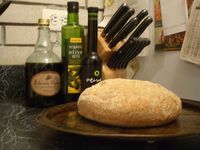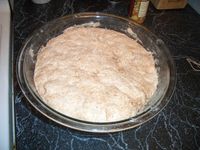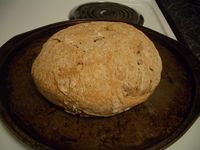Adventures with Sourdough

Emily Weingarten | Contributor
I finally visited Lisa a couple weeks ago to pick up the starter and see how she makes fantastic bread using the no-knead method. Lisa made her starter almost one year ago using fermented grapes. She “feeds” the sourdough starter twice weekly with equal parts flour (wheat or white) and distilled water and stores the active cultures in an air-tight jar in the refrigerator. I was curious to know what exactly makes the sourdough starter so special, so I’ve been poking around on the Internet this week looking for reliable information. Finally, I found a great article on HowStuffWorks.com, the website for a podcast I love to listen to when I feel like learning random facts of life.
According to HowStuffWorks.com, making sourdough requires grain, water, and a source of yeast. The yeast is the fungus that is able to break down the starches in wheat four via fermentation to form sugar, making the bread rise. The big difference between commercial yeast fungi and sourdough yeast fungi is that sourdough is alive! While commercial yeast is dried, preserved, and made into a powder, the sourdough fungi need to be kept alive and active in a liquid medium called a starter. These active cultures are what give sourdough bread its distinctive flavor.
Perhaps the fact that sourdough leaving is constantly alive, waiting to be used for bread, whereas conventional bread yeast needs to be “activated,” is what makes sourdough so intriguing. The art of making sourdough is ancient, and sourdough bread is actually much more nutritious than breads made with dried yeast. Here’s some insight on natural leaving methods from Jacques DeLangre, Ph.D. (excerpt from Sally Fallon’s Nourishing Traditions):
"In books on baking and even in nutritional/medical writings, the two techniques [for making bread], natural leaven (sourdough) and baker’s yeast, are often mingled and confounded…. Baking with natural leaven is in harmony with nature and maintains the integrity and nutrition of the cereal grains used…. The process helps to increase and reinforce our body’s absorption of the cereal’s nutrients. Unlike yeasted bread that diminishes, even destroys, much of the grain’s nutritional value, naturally leavened bread does not stale and, as it ages, maintains its original moisture much longer."
DeLangre goes on to say that yeast was introduced into Louis XIV’s court in 1668, it was strongly rejected because of perceived health risks. Today, scientific evidence is proving these fears valid, that commercial yeast actually destroys many of the nutrients bread can offer.
After I learned about how the starter works, I began to wonder why the sourdough doesn’t start growing lots of other types of bacteria and mold. Of course, HowStuffWorks had the answer. The starch in the bread flour, unlike sugar, is not something in which many types of bacteria can live. Conveniently, yeast contains special enzymes that allow it to cohabitate with the starch. The lactobacilli—the type of bacteria found in the starter—along with the yeast, also produce alcohol and lactic acid that keep other bacteria from growing. Way to go Mother Nature.
After I expanded the starter enough by adding equal parts whole-wheat flour and distilled water two or three times per week, I was ready to make my bread. It took some coordinating with my work schedule since the no-knead bread needs to proof for 18 hours, followed by a second 1 ½-hour proofing phase, and then bake for nearly one hour.
Lisa recommended the no-knead sourdough bread method from Breadtopia, a fantastic resource for making bread. Breadtopia not only has recipes, discussions, and bread-making products for sale, but videos that demonstrate the bread-making methods, which can sometimes be hard to describe with words.
On Monday afternoon, I mixed together in a large bowl: 1 cup white flour 2 ½ cups whole wheat flour 1 ½ tsp salt
In a smaller bowl, I mixed: 1 ½ cups distilled water ¼ cup (heaping) sourdough starter
I then mixed the liquid mixture into the flour mixture and stirred until dough formed. I covered the large bowl with plastic wrap and allowed the bread to “proof” for 18 hours in the oven (heat off).

The dough after 18 hours of proofing.
Emily Weingarten | Contributor
About one hour into the rising time, I preheated the oven to 450 degrees and placed a baking pan filled with water on the lowermost oven rack. Creating steam in the oven allows for the sourdough to bake in a humid environment, which ultimately allows for the crusty crust characteristic of traditional sourdough bread. When the dough was finished with its second rising period, I placed the dough on to a greased cookie sheet and baked the bread in the humid oven at 450 degrees for 20 minutes. After the 20 minutes, I removed the water pan, lowered the heat to 375 degrees and baked for another 40 minutes.

The finished product, slightly dense, but still aromatic and delicious.
Emily Weingarten | Contributor
Emily Weingarten is a new contributor to AnnArbor.com's Food and Drink section. You can follow Emily's blog at http://a2create.blogspot.com and contact Emily at emilyweingarten@gmail.com.


Comments
BrianR
Sat, Feb 13, 2010 : 1:33 p.m.
If you want to learn more about sourdough, here's a great place to start: http://www.bakewithzing.com/class.php?id=13
Erin Mann
Sat, Feb 13, 2010 : 11:14 a.m.
Great article, Emily! I look forward to hearing about the changes you make to the recipe/technique.